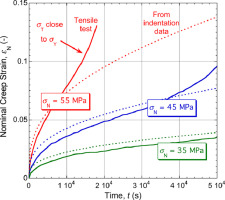当前位置:
X-MOL 学术
›
Int. J. Mech. Sci.
›
论文详情
Our official English website, www.x-mol.net, welcomes your
feedback! (Note: you will need to create a separate account there.)
A Methodology for obtaining Primary and Secondary Creep Characteristics from Indentation Experiments, using a Recess
International Journal of Mechanical Sciences ( IF 7.1 ) Pub Date : 2020-06-01 , DOI: 10.1016/j.ijmecsci.2020.105577 M. Burley , J.E. Campbell , J. Dean , T.W. Clyne
International Journal of Mechanical Sciences ( IF 7.1 ) Pub Date : 2020-06-01 , DOI: 10.1016/j.ijmecsci.2020.105577 M. Burley , J.E. Campbell , J. Dean , T.W. Clyne

|
Abstract A procedure is described for Indentation Creep Plastometery (using a spherical indenter), which is analogous to that developed previously for Indentation Plastometry. As in that case, it is based on iterative numerical simulation of the indentation process, with repeated comparison between an experimental outcome and the corresponding model prediction, systematically varying the values of parameters in a constitutive law until optimal agreement is achieved. The constitutive law used here is the Miller–Norton relationship, which covers both primary and secondary creep regimes (although the transition between them is not well-defined). The experimental outcome is the penetration depth as a function of time, under a constant applied load. An important feature of the procedure is the prior creation of a spherical recess in the sample, having a pre-selected depth and a curvature radius equal to that of the indenter. This allows control over the stress levels created during the indentation creep testing and can be used to ensure that no (time-independent) plastic deformation is stimulated during the test. In the absence of such a recess, this is virtually unavoidable, since the stress levels created during initial contact between a spherical indenter and a flat surface tend to be very high. Such plasticity introduces unwanted complications into creep testing. Confirmation of the viability of the procedure is provided via comparisons between the creep characteristics of pure nickel samples at 750 °C, obtained in this way and via conventional uniaxial tensile testing.
中文翻译:

使用凹槽从压痕实验中获得主要和次要蠕变特性的方法
摘要 描述了压痕蠕变塑性测量(使用球形压头)的程序,它类似于先前为压痕塑性测量开发的程序。在这种情况下,它基于压痕过程的迭代数值模拟,反复比较实验结果和相应的模型预测,系统地改变本构法中的参数值,直到达到最佳一致性。这里使用的本构定律是 Miller-Norton 关系,它涵盖了初级和次级蠕变状态(尽管它们之间的过渡没有明确定义)。实验结果是在恒定施加载荷下作为时间的函数的穿透深度。该程序的一个重要特征是在样品中预先创建一个球形凹槽,具有预先选定的深度和与压头相同的曲率半径。这允许控制在压痕蠕变测试期间产生的应力水平,并可用于确保在测试期间没有(与时间无关的)塑性变形受到刺激。在没有这种凹槽的情况下,这实际上是不可避免的,因为在球形压头和平面之间的初始接触期间产生的应力水平往往非常高。这种可塑性在蠕变测试中引入了不需要的复杂性。通过比较以这种方式获得的纯镍样品在 750 °C 下的蠕变特性和常规单轴拉伸试验,可以确认该程序的可行性。这允许控制压痕蠕变测试期间产生的应力水平,并可用于确保在测试期间没有(与时间无关的)塑性变形受到刺激。在没有这种凹槽的情况下,这实际上是不可避免的,因为在球形压头和平坦表面之间的初始接触期间产生的应力水平往往非常高。这种可塑性在蠕变测试中引入了不需要的复杂性。通过比较以这种方式获得的纯镍样品在 750 °C 下的蠕变特性和常规单轴拉伸试验,可以确认该程序的可行性。这允许控制在压痕蠕变测试期间产生的应力水平,并可用于确保在测试期间没有(与时间无关的)塑性变形受到刺激。在没有这种凹槽的情况下,这实际上是不可避免的,因为在球形压头和平面之间的初始接触期间产生的应力水平往往非常高。这种可塑性在蠕变测试中引入了不需要的复杂性。通过比较以这种方式获得的纯镍样品在 750 °C 下的蠕变特性和常规单轴拉伸试验,可以确认该程序的可行性。这实际上是不可避免的,因为在球形压头和平面之间的初始接触期间产生的应力水平往往非常高。这种可塑性在蠕变测试中引入了不需要的复杂性。通过比较以这种方式获得的纯镍样品在 750 °C 下的蠕变特性和常规单轴拉伸试验,可以确认该程序的可行性。这实际上是不可避免的,因为在球形压头和平面之间的初始接触期间产生的应力水平往往非常高。这种可塑性在蠕变测试中引入了不需要的复杂性。通过比较以这种方式获得的纯镍样品在 750 °C 下的蠕变特性和常规单轴拉伸试验,可以确认该程序的可行性。
更新日期:2020-06-01
中文翻译:

使用凹槽从压痕实验中获得主要和次要蠕变特性的方法
摘要 描述了压痕蠕变塑性测量(使用球形压头)的程序,它类似于先前为压痕塑性测量开发的程序。在这种情况下,它基于压痕过程的迭代数值模拟,反复比较实验结果和相应的模型预测,系统地改变本构法中的参数值,直到达到最佳一致性。这里使用的本构定律是 Miller-Norton 关系,它涵盖了初级和次级蠕变状态(尽管它们之间的过渡没有明确定义)。实验结果是在恒定施加载荷下作为时间的函数的穿透深度。该程序的一个重要特征是在样品中预先创建一个球形凹槽,具有预先选定的深度和与压头相同的曲率半径。这允许控制在压痕蠕变测试期间产生的应力水平,并可用于确保在测试期间没有(与时间无关的)塑性变形受到刺激。在没有这种凹槽的情况下,这实际上是不可避免的,因为在球形压头和平面之间的初始接触期间产生的应力水平往往非常高。这种可塑性在蠕变测试中引入了不需要的复杂性。通过比较以这种方式获得的纯镍样品在 750 °C 下的蠕变特性和常规单轴拉伸试验,可以确认该程序的可行性。这允许控制压痕蠕变测试期间产生的应力水平,并可用于确保在测试期间没有(与时间无关的)塑性变形受到刺激。在没有这种凹槽的情况下,这实际上是不可避免的,因为在球形压头和平坦表面之间的初始接触期间产生的应力水平往往非常高。这种可塑性在蠕变测试中引入了不需要的复杂性。通过比较以这种方式获得的纯镍样品在 750 °C 下的蠕变特性和常规单轴拉伸试验,可以确认该程序的可行性。这允许控制在压痕蠕变测试期间产生的应力水平,并可用于确保在测试期间没有(与时间无关的)塑性变形受到刺激。在没有这种凹槽的情况下,这实际上是不可避免的,因为在球形压头和平面之间的初始接触期间产生的应力水平往往非常高。这种可塑性在蠕变测试中引入了不需要的复杂性。通过比较以这种方式获得的纯镍样品在 750 °C 下的蠕变特性和常规单轴拉伸试验,可以确认该程序的可行性。这实际上是不可避免的,因为在球形压头和平面之间的初始接触期间产生的应力水平往往非常高。这种可塑性在蠕变测试中引入了不需要的复杂性。通过比较以这种方式获得的纯镍样品在 750 °C 下的蠕变特性和常规单轴拉伸试验,可以确认该程序的可行性。这实际上是不可避免的,因为在球形压头和平面之间的初始接触期间产生的应力水平往往非常高。这种可塑性在蠕变测试中引入了不需要的复杂性。通过比较以这种方式获得的纯镍样品在 750 °C 下的蠕变特性和常规单轴拉伸试验,可以确认该程序的可行性。









































 京公网安备 11010802027423号
京公网安备 11010802027423号